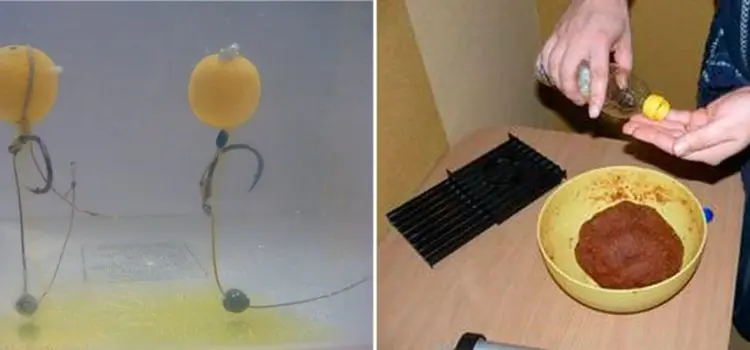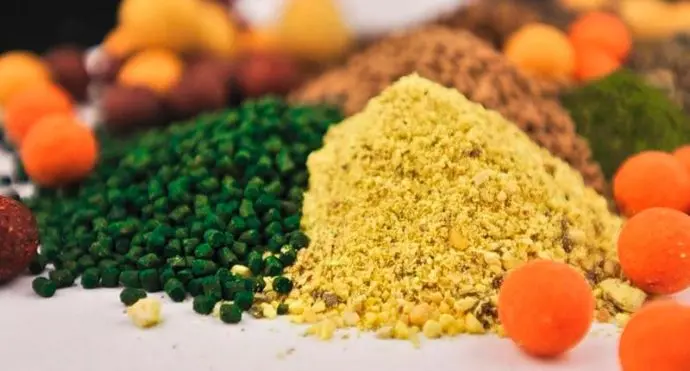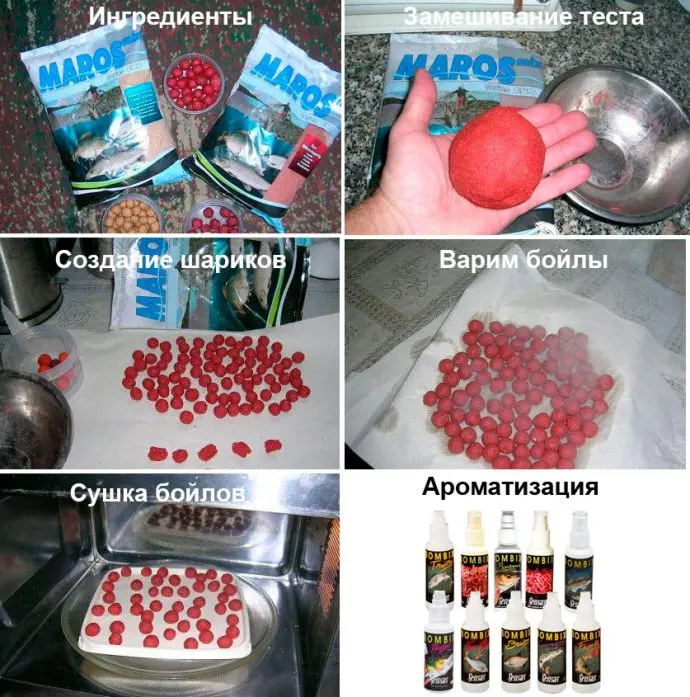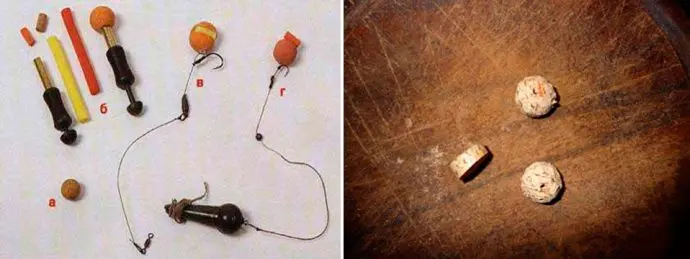Contents

This type of bait, called Pop Up, is an artificial bait used when catching fish such as carp or carp. This article will tell you how to make floating boilies with your own hands.
Boyle – This is a ball with a diameter of about 2 cm, having a bright coloring and which includes various ingredients, both animal and vegetable origin. In addition, flavor and odor enhancers are added to the composition.
Boilies can have the following characteristics:
- sinking;
- neutral;
- floating.
All of them are designed for certain fishing conditions. So, in the presence of a muddy bottom, it is undesirable to use sinking boilies, since they will drown in the mud and remain invisible to the fish. In this case, it is better to use boilies with neutral buoyancy. They will be in close proximity to the bottom. But after a certain time, the smell of silt and aquatic vegetation will clog the aroma of boilies. But floating boilies are ideal for such fishing conditions, as they will constantly be in the water column without losing their attractive characteristics.
Ingredients for floating boilies

Regardless of what kind of boilies they are – sinking, neutral or floating, their composition is almost identical. They differ from each other only in the technology of preparing the dough: sinking boilies are boiled, and floating boilies are cooked in the microwave. At the same time, the composition of boilies can be very diverse. The composition of the dough includes dry ingredients, binders and aromatics. All this, taken together, is mixed with eggs or water.
Boilies can contain both nutritious and low-calorie ingredients. It all depends on the fishing conditions. If you need to attract fish for a short time, then you can use low-calorie boilies with a pronounced aroma, if you need to attract fish for a long period, then high-calorie boilies are used along with bait.
Animal Ingredients:
- meat products;
- chopped fish;
- crushed bones and meat;
- casein and milk.
Herbal Ingredients:
- various flour;
- various cereals;
- birdseed.
Of great importance is the color and aroma of boilies, therefore, various flavors and dyes should be introduced into the main composition.
Flavors can be:
- chocolate;
- various oils;
- sunflower seeds (crushed);
- curry;
- caraway;
- cinnamon;
- garlic.
If meat or poultry food is added to the mixture, then flavors can be discarded, and if the composition includes fresh elements such as flour, cereals, then flavors are necessary.
The color of the boilies should be in contrast to the underwater world. Bright colors such as red, yellow, orange, etc. are more suitable.
Steps for making floating boilies

- Dry and liquid components are mixed together.
- After that, the dough is kneaded until a homogeneous consistency.
- The whole batch is divided into several parts.
- And sausages are formed from each part, after which they are cut into small pieces.
- Balls are formed from small pieces and laid out on a pallet.
After that, boilies are made from the resulting balls. If you boil them and then dry them, you get sinking baits. To get floating baits, you can use several methods. The easiest option is based on baking them in the microwave. In this case, the maximum power is selected. Boilies are considered ready if they have already begun to burn, but this state should not be allowed. How buoyant the boilies turned out can be checked in a glass of water. With the help of such experiments, you can choose and determine the size of boilies. After that, hooks are selected for such boilies. It is very important that the hook does not pull the boilie to the bottom, and the bait with the hook remains in the water column.
There is another option. To ensure the buoyancy of boilies, cork material can be used:

- To do this, crush the cork and add to the main mixture. Such boilies are not baked in the microwave, but boiled.
- Use pieces of cork. To do this, they are covered with dough and boiled.
- You can make a sinking boilie float by drilling a hole in it and inserting a piece of cork into it. Unfortunately, this process is quite laborious.
If you make boilies based on cork, then their diameter should not be more than 15 mm, since the cork has too much buoyancy. Although, the buoyancy of the boilies can be adjusted by the size of the cork pieces, and after lengthy trials, you can decide on this issue.
Floating Boilies Recipes
There are a lot of such options, and they are all designed for specific fishing conditions.
Recipe No.1
- Semolina – 250 g;
- Soy flour – 200 g;
- Corn flour – 150 g;
- Chopped peas – 80 g;
- Powdered milk – 80 g;
- Ground hemp – 100 g;
- Flavors and dyes – 100 g;
Recipe #2
- Grated potatoes;
- Smooth parts of semolina and flour (1: 1);
- Hemp cake;
- Eggs;
- Dyes and flavors.
Recipe No.3
- Bird food – 400 g;
- Soy flour – 300 g;
- Wheat flour – 90 g;
- Starch – 90 g;
- Ground peanuts – 90 g;
- Flavorings and dyes.
Recipe No.4
- 1 cup crushed seeds;
- 2 cups soy flour;
- 4 cups of fish flour;
- 1,5 cups of grains;
- Eggs.
Recipe No.5
- Bird food – 1,5 cups;
- Soy flour – 1 cup;
- Sunflower seeds, flax or hemp – 0,5 cups;
- Krupchatka – 1 cup;
- Eggs.
Typically, boilies are made from elaborate recipes to make them more appealing to the fish. Such baits can also be made from store-bought dry mixes that have the same purpose.
In the summer, carp and carp prefer boilies, where vegetable ingredients are included. In spring and autumn, it is desirable to add animal components to the mixture. For fishing in the winter, when carp and carp eat very rarely, it is worth making boilies with the most vivid smells and colors.
Hair Snap for Pop Up
Taking food, the carp sucks it in and then, in the mouth, divides the food into edible or non-edible, after which the latter is thrown away. If during suction he feels something suspicious, then he may refuse food. Hair rigging allows you to hide the hook away from the object of carp suction, and when he feels something is wrong, it will be too late and he will not be able to get rid of the hook.
Boil tackle.Pop-up.Carp tackle.Fishing.Fishing
To link such a snap you need to have:
- A piece of fishing line, about 20 cm long;
- carp hook;
- silicone tube;
- Stopper;
- Special needle.
To have a hair snap, you will need to do the following operations:
- A loop is knitted at the end of a piece of fishing line. It will be required to fix the boilie.
- Put a silicone tube on the fishing line, and then tie a hook to it.
- Pass the free end of the fishing line through the tube in the opposite direction.
- Using a tool (needle), make a hole in the boilie. After that, grab the free end of the fishing line with a needle and pull it through the boilie, and then fix it.
- Take a small needle and pierce the boilie in several places.
The hair accessory is ready for use.
The advantages of such equipment
- Ease. It fits without much difficulty in any conditions, including on the pond.
- Reliability. There is a very high probability of catching fish, since the bait and hook are at some distance, which does not allow the carp to detect it ahead of time.
- Security. This montage is the most humane. This is due to the fact that in the presence of a hair rig, the fish clings to the lip. After that, she can be released from the hook and released without harming her.
Making Pop Ups Floating Boilies at Home
Summary results
As can be seen from the information, it is not so difficult to make floating boilies yourself, it is enough to do the following operations and stock up on patience and ingredients:
- Pick up the components, depending on the conditions of fishing.
- Decide on the technology for preparing floating boilies: whether it is heat treatment in the microwave, or cooking, using cork material.
- Correctly mount the hair rig with the boilie.
In stores for anglers you can find a variety of boilies for all fishing conditions. It is possible that they are more effective than homemade ones, but they are much more expensive. Therefore, in order not to pay extra money, anglers resort to the independent manufacture of various baits, including boilies. Well, and whoever has the opportunity to buy ready-made boilies, he will not engage in their independent production.









